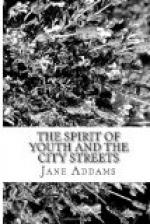To emphasize the eternal aspects of love is not of course an easy undertaking, even if we follow the clue afforded by the heart of every generous lover. His experience at least in certain moments tends to pull him on and out from the passion for one to an enthusiasm for that highest beauty and excellence of which the most perfect form is but an inadequate expression. Even the most loutish tenement-house youth vaguely feels this, and at least at rare intervals reveals it in his talk to his “girl.” His memory unexpectedly brings hidden treasures to the surface of consciousness and he recalls the more delicate and tender experiences of his childhood and earlier youth. “I remember the time when my little sister died, that I rode out to the cemetery feeling that everybody in Chicago had moved away from the town to make room for that kid’s funeral, everything was so darned lonesome and yet it was kind of peaceful too.” Or, “I never had a chance to go into the country when I was a kid, but I remember one day when I had to deliver a package way out on the West Side, that I saw a flock of sheep in Douglas Park. I had never thought that a sheep could be anywhere but in a picture, and when I saw those big white spots on the green grass beginning to move and to turn into sheep, I felt exactly as if Saint Cecilia had come out of her frame over the organ and was walking in the park.” Such moments come into the life of the most prosaic youth living in the most crowded quarters of the cities. What do we do to encourage and to solidify those moments, to make them come true in our dingy towns, to give them expression in forms of art?
We not only fail in this undertaking but even debase existing forms of art. We are informed by high authority that there is nothing in the environment to which youth so keenly responds as to music, and yet the streets, the vaudeville shows, the five-cent theaters are full of the most blatant and vulgar songs. The trivial and obscene words, the meaningless and flippant airs run through the heads of hundreds of young people for hours at a time while they are engaged in monotonous factory work. We totally ignore that ancient connection between music and morals which was so long insisted upon by philosophers as well as poets. The street music has quite broken away from all control, both of the educator and the patriot, and we have grown singularly careless in regard to its influence upon young people. Although we legislate against it in saloons because of its dangerous influence there, we constantly permit music on the street to incite that which should be controlled, to degrade that which should be exalted, to make sensuous that which might be lifted into the realm of the higher imagination.
Our attitude towards music is typical of our carelessness towards all those things which make for common joy and for the restraints of higher civilization on the streets. It is as if our cities had not yet developed a sense of responsibility in regard to the life of the streets, and continually forget that recreation is stronger than vice, and that recreation alone can stifle the lust for vice.




